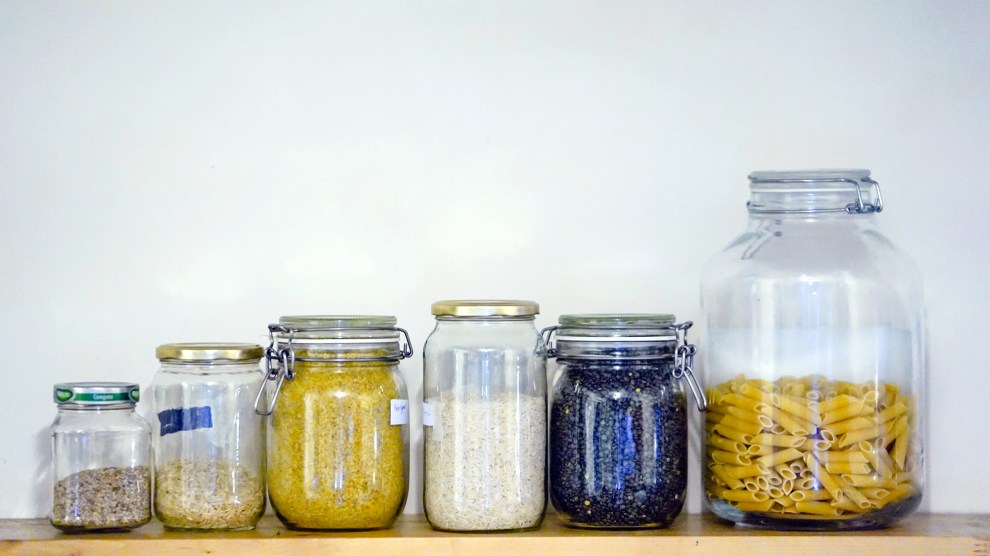
Isopix/ZUMA
As shoppers stock up for their coronavirus quarantines, grocery stores across the country have come to resemble picked-over wastelands. But buying 40 cans of beans might not be the best way to stay fed throughout the pandemic.
Instead, chef and writer Tamar Adler suggests using your time at home to cook meals that stretch the ingredients you already have on-hand to their maximum potential. “Given how much stuff so many of us have sitting in our pantries anyway,” says Adler, “I would encourage people to refocus their approach from stocking up to using what you have.”
Tamar Adler is the author of An Everlasting Meal: Cooking with Economy and Grace, and the host of the Food Actually podcast. She joined Kiera Butler on Bite to share some of her favorite tips for making the food in your pantry last. And, of course, we got her to share some recipes.
Tip #1: Instead of panic-shopping, start by eating your leftovers.
Try not to let anything go to waste. “Anything that seems like it’s starting to go bad is dinner tonight,” says Adler. “This is a really good time to braise all the little bits of whatever you have in your freezer, or to do something with the end of the salami. Deal with all the bits and bobs right now.”
Tip #2: Stock up on transformative ingredients: fats, salt, garlic, onions, and herbs.
Ingredients like butter, coconut oil, seaweed, anchovies, garlic, onion, vinegar, and fresh parsley have the power to revolutionize a dish. “Buying things that enable you to transform what you already have is a better approach than trying to make sure you have anything you could ever need,” says Adler.
Tip #3: Develop a “house meal.”
This is something you can make quickly from the food you have in the house. It shouldn’t be so unhealthy that you feel bad after eating it, or so virtuous that you don’t crave it. Right now, Adler’s go-to house meal for her and her family is boiled eggs, beans, greens, and pickled chiles for the grownups. If they don’t have fresh greens, they toast a slice of bread for the base.
Tip #4: Make foods that stretch your ingredients.
These are also budget friendly! Think chicken stock, braised meat or vegetables, and pots of beans. Adler is a big fan of foods like pancakes and meatballs, which can be flexible and help stretch other ingredients. She makes pancakes for dinner about once a week, using whatever she has on-hand: leftover vegetables, like carrots or kimchi or scallions or broccoli, and whatever base ingredients she has available, from buttermilk to sourdough to whey to rice flour. Another go-to in the Adler household: a roast chicken, the carcass of which she uses to make broth for a chicken and rice soup the next day.
Tip #5: If you are quarantined with kids, involve your kids in food preparation.
This is a good trick with kids who are picky eaters, or won’t eat vegetables. If kids stem the kale, they’re more likely to eat the kale. It serves the dual purpose of keeping them occupied. Adler has a young son who doesn’t like to eat vegetables, but when he helps chop them with his toddler-knife, he’s more likely to eat them. He loves to peel carrots, make popovers, and cut dough into shapes.
Tip #6: Look for recipes from cuisines that don’t throw anything out.
Adler has been looking at Italian, Korean, Japanese, and Chinese styles of cooking. These cultures have great recipes that use all of your leftovers—even a single stock of celery, or a sad carrot. She has also been enjoying experimenting with Indian street-food snacks, which are full of flavor but use only a few ingredients. “Looking at cultures where it’s looked down upon to throw anything out, you’ll find recipes for stuff that you would not have used otherwise,” says Adler.
Tip #7: Prepare and freeze foods that you’ll be able to eat if you get sick.
If you do come down with COVID-19, the disease caused by the coronavirus, you’ll be thankful to have soup in the freezer that you can throw on the stove. Adler just made a ton of dashi because her favorite sick meal is miso soup, which only requires four pieces of kelp and two bags of bonito flakes for a huge pot. “Making any kind of stock and freezing it would be a great idea,” says Adler.
Given that on normal days every American wastes one pound of food, this quarantine could be a great time to learn how to be better about using what we have. Cooking meals with the people in your home is one of the few normal things we’ll be able to do in the next few weeks. But that doesn’t require going out and buying unusual amounts of ingredients.
“We have taken a fairly standard capitalist approach to the fears of the moment,” says Adler, “and imagined that there’s some amount of dried pasta and olive oil and toilet paper we could buy that would insulate us. I just don’t think it’s true.”
Chickpea Pasta
Serves 2-3
Ingredients
- 15 ounces (1 1/2 to 1 3/4 cups) canned, no-salt-added chickpeas
- 2 tablespoons olive oil
- 1 clove garlic, cut into thin slices
- Kosher or sea salt
- Water
- Freshly ground black pepper
- 8 ounces dried pasta in shapes, such as penne, orecchiette, farfalle or elbow macaroni
Directions
Drain the chickpeas in a colander, then rinse them for a minute.
Heat the oil in a small, deep pot over medium-low heat until the oil begins to shimmer. Stir in the garlic and reduce the heat to low; cook until the garlic has softened, about 5 minutes.
Add the chickpeas, a pinch of salt and enough water to barely cover the chickpeas. Increase the heat to medium, so the liquid is barely bubbling around the edges.
Cook uncovered for 30 to 45 minutes, adding small amounts of water as needed to keep the beans barely moistened. Taste five of the chickpeas; if any of them are not completely velvety inside, cook them a bit longer until all the chickpeas are quite tender. Reduce the heat to the lowest possible setting. Season with pepper to taste.
Meanwhile, bring a pot of water to a boil over medium-high heat. Add a generous pinch of salt and the pasta; cook according to the package directions. Just before you drain the pasta, reserve about 1/2 cup of the pasta cooking water.
Stir about 2 tablespoons of the reserved pasta cooking water into the chickpeas; this liquid should become integrated fairly quickly.
Combine the still-warm pasta and the chickpeas and any of their remaining liquid in a mixing bowl, stirring vigorously enough to help form a creamy sauce. If the mixture seems dry, or if the creamy chickpeas aren’t sticking to the pasta, add more of the pasta cooking water and stir to incorporate. Taste and adjust seasoning as needed.
Eat one serving hot; reserve the rest for another day, to enjoy cold or rewarmed.
Cream Cheese Pastry Dough for Hand Pies or Empanadas
* Great for kids!
Ingredients
- 6 tablespoons salted or unsalted butter, cut into pieces
- half a package (4 oz) of cream cheese
- 1 cup all-purpose flour
- 1/2 teaspoon salt
Directions
Combine all in a food processor until it just comes together. Easiest to do by pulsing. Press into disk.
Wrap with plastic wrap or wax paper and refrigerate 1-8 hours. Bring to room temperature for 10-15 minutes. Roll out as thinly as possible. Cut into little rounds.
Make sweet hand-pies by adding 1/4 teaspoon (or less) leftover jam to the bottom half of each.
Make little empanadas by filling with something savory—like oil packed tuna, warmed up in the oil with a little chopped onion and garlic (which you can cook in the tuna oil) or chopped ham/prosciutto, or grated cheese.
Crimp or squeeze edges. Brush with an egg white beaten with a few sprinkles of water. Bake at 375° Fahrenheit for 15 minutes, or until golden.
















